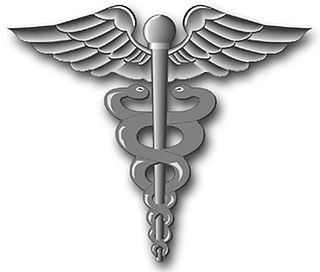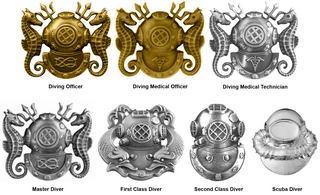A United States military occupation code, or a military occupational specialty code, is a nine-character code used in the United States Army and United States Marine Corps to identify a specific job. In the United States Air Force, a system of Air Force Specialty Codes (AFSC) is used. In the United States Navy, a system of naval ratings and designators are used along with the Navy Enlisted Classification (NEC) system. A system of ratings is also used in the United States Coast Guard.

The Fleet Marine Force Ribbon, officially the Navy Fleet Marine Force Service Ribbon, was a military award of the United States Navy established in 1984 by Secretary of the Navy, John F. Lehman, Jr. The service ribbon was awarded to eligible Navy personnel serving with the Marine Corps between 1984 and 2006. The award signified the acquisition of specific professional skills, knowledge and military experience that resulted in qualifications above those normally required of Navy personnel serving with the Fleet Marine Force (FMF). The FMF Ribbon was discontinued in the mid-2000s due to the promulgation of the FMF badges.
The Fleet Marine Force Warfare Insignia, also known as the Fleet Marine Force badge or FMF pin, are three military badges of the United States Navy which are issued to those U.S. Navy officers and sailors who are trained and qualified to perform duties in support of the United States Marine Corps. There are currently three classes of the Fleet Marine Force pin, being that of enlisted, officer, and chaplain.

The Explosive Ordnance Disposal Badge is a military badge of the United States Armed Forces which recognizes those service members, qualified as explosive ordnance disposal (EOD) technicians, who are specially trained to deal with the construction, deployment, disarmament, and disposal of high explosive munitions including other types of ordnance such as nuclear, biological and chemical weapons along with improvised explosive devices (IED) and improvised nuclear devices (IND). Also known as the “EOD Badge” or "Crab", the decoration is issued by the United States Army, Air Force, Navy and Marine Corps. The EOD Badge is the only occupational badge awarded to all four services under the United States Department of Defense.
The Navigator Badge is a military qualification badge of the United States Air Force which was first created during the Second World War. The current USAF badge is designated by Air Force Instructions as the Navigator/Observer Badge and is issued to rated officers in both rating categories. In 2009, it was renamed as the Combat Systems Officer badge.
The Enlisted Aviation Warfare Specialist (EAWS) insignia is a military badge of the United States Navy which was created in March 1980. The insignia recognizes those members of the Navy's enlisted force who have acquired the specific professional skills, knowledge, and military experience that result in qualification for service in the aviation activities of the Navy. This includes most personnel who are trained flight deck personnel onboard aircraft carriers, or maintenance personnel at an Aircraft Intermediate Maintenance Detachment or Department (AIMD) or aircraft squadron.

The Parachutist Badge, also commonly referred to as "Jump Wings" is a military badge of the United States Armed Forces. The United States Space Force and United States Coast Guard are the only branches that do not award the Parachutist Badge, but their members are authorized to receive the Parachutist Badges of other services in accordance with their prescribed requirements. The DoD military services are all awarded the same Basic Parachutist Badge. The U.S. Army and U.S. Air Force issue the same Senior and Master Parachutist Badges while the U.S. Navy and U.S. Marine Corps issue the Navy and Marine Corps Parachutist Badge to advanced parachutists. The majority of the services earn their Basic Parachutist Badge through the U.S. Army Airborne School.

Insignias and badges of the United States Navy are military badges issued by the United States Department of the Navy to naval service members who achieve certain qualifications and accomplishments while serving on both active and reserve duty in the United States Navy. Most naval aviation insignia are also permitted for wear on uniforms of the United States Marine Corps.

Insignia and badges of the United States Marine Corps are military "badges" issued by the United States Department of the Navy to Marines who achieve certain qualifications and accomplishments while serving on both active and reserve duty in the United States Marine Corps.
The Aircrew Badge, commonly known as Wings, is a qualification badge of the United States military that is awarded by all five branches of armed services to personnel who serve as aircrew members on board military aircraft. The badge is intended to recognize the training and qualifications required by aircrew of military aircraft. In order to qualify as an aircrew member and receive the Aircrew Badge, such personnel typically undergo advanced training in aircraft in-flight support roles.

A hospital corpsman is an enlisted medical specialist of the United States Navy, who may also serve in a U.S. Marine Corps unit. The corresponding rating within the United States Coast Guard is health services technician (HS).

The United States Navy master diver is the highest warfare qualification obtainable by a member of U.S. Navy diving community. A master diver is an enlisted person who typically has the most experience and knowledge on all aspects of diving and underwater salvage.

This is a list of Royal Navy ratings rank insignia.

The United States Fleet Marine Forces (FMF) are combined general- and special-purpose forces within the United States Department of the Navy that perform offensive amphibious or expeditionary warfare and defensive maritime employment. The Fleet Marine Forces provide the National Command Authority (NCA) with a responsive force that can conduct operations in any spectrum of conflict around the globe.

Aircrew survival equipmentmen are survival equipment specialists and certified parachute riggers who oversee valuable life saving equipment, parachutes, and other special gear used by U.S. Naval and Marine Corps special operations forces, Naval Air Department, and the United States Navy Parachute Team known as the "Leap Frogs". They perform a wide range of duties, which include inspecting, maintaining, and repairing parachutes, search and rescue equipment, along with survival kits, medical kits, flight clothing, protective wear, night vision equipment, aircrew oxygen systems, liquid oxygen converters, anti-exposure suits, and g-suits. PRs operate and maintain carbon dioxide transfer and recharge equipment, operate and repair sewing machines as well as train aircrew and other personnel in parachute rigging and the use of safety and survival equipment.
The Enlisted Information Warfare Specialist Insignia (EIWS) is a military badge of the United States Navy which was created in 2010. The insignia recognizes those members of the Navy's enlisted force who have acquired the specific professional skills, knowledge, and military experience that result in qualification for service in the information warfare activities of the Navy.









